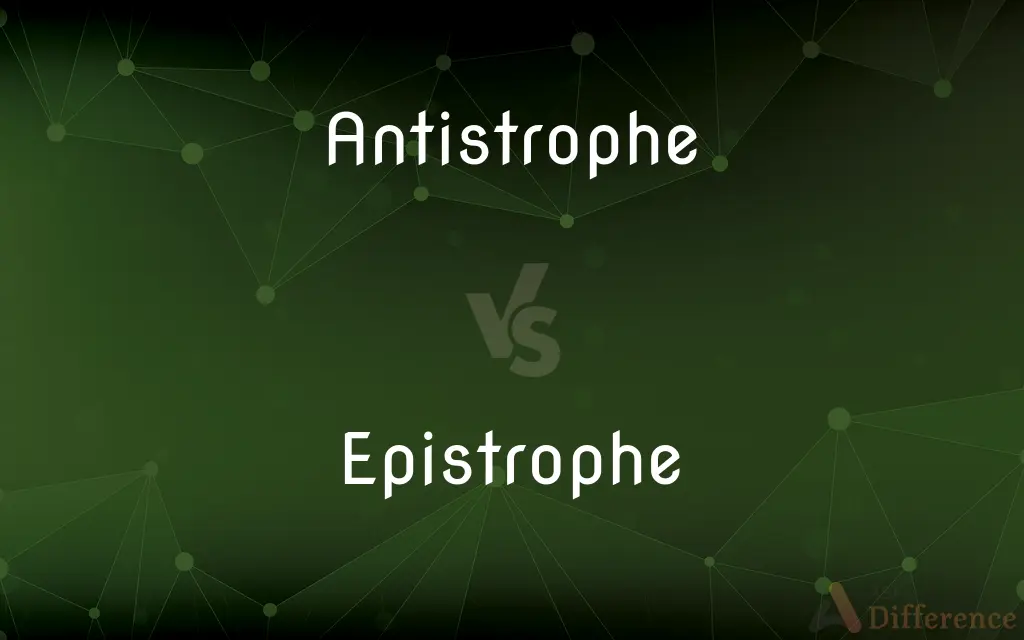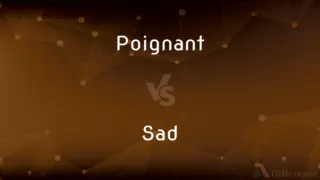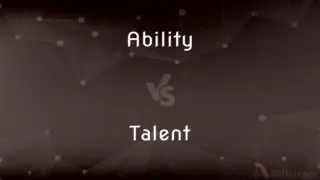Antistrophe vs. Epistrophe — What's the Difference?
By Tayyaba Rehman & Urooj Arif — Updated on April 17, 2024
Antistrophe involves the repetition of the same word or phrase at the end of successive clauses, while epistrophe is specifically the repetition at the end of consecutive sentences.

Difference Between Antistrophe and Epistrophe
Table of Contents
ADVERTISEMENT
Key Differences
Antistrophe is a rhetorical device used to emphasize a phrase by repeating it at the end of successive clauses, enhancing the rhythm and impact of the speech. Whereas, epistrophe also repeats phrases at sentence ends but is particularly noted for its use across consecutive sentences, creating a powerful and memorable conclusion to each segment.
Both antistrophe and epistrophe serve to make the text more memorable and persuasive, but antistrophe is often used within a single complex sentence or within a series of closely related clauses. On the other hand, epistrophe is more likely to appear in speeches and writings where the repetition spans several sentences, emphasizing a concluding thought in each.
Antistrophe can be found in a variety of literary and public speaking contexts, aiming to unify a section of text around a central theme. Whereas epistrophe is especially prominent in political speeches and persuasive writings, where the repetition reinforces a key point or emotion.
While antistrophe subtly builds up emphasis through its pattern, making the audience more engaged and focused, epistrophe's repetition can have a more immediate and forceful impact, often used to evoke strong emotional responses from the audience.
The stylistic use of antistrophe tends to be more poetic and is commonly used in literature and poetry to tie together complex ideas and emotions. Conversely, epistrophe is straightforward and is utilized effectively in arguments and presentations to highlight and reinforce a final point.
ADVERTISEMENT
Comparison Chart
Definition
Repetition at the end of successive clauses
Repetition at the end of consecutive sentences
Usage Context
Literary works, speeches
Primarily in speeches and persuasive writings
Purpose
To enhance rhythm, unify ideas
To reinforce a point, evoke emotional response
Impact
Subtle build-up of emphasis, poetic
Immediate and forceful impact
Audience Engagement
Requires attentive listening/reading
Easier for audiences to recognize and recall
Compare with Definitions
Antistrophe
Appears in poetry and speeches.
Where now? Who now? When now?
Epistrophe
Clear and memorable repetition.
You need it, you deserve it, you have it.
Antistrophe
Used to emphasize and unify ideas.
For the people, by the people, of the people.
Epistrophe
Intended to evoke a strong emotional response.
What lies behind us and what lies before us are tiny compared to what lies within us.
Antistrophe
Repetition of words at the end of successive clauses.
When I was a child, I spoke as a child, I understood as a child, I thought as a child.
Epistrophe
Repetition of a phrase at the end of consecutive sentences.
See no evil, hear no evil, speak no evil.
Antistrophe
Enhances rhythm and engagement.
He's happy, she's happy, we're all happy.
Epistrophe
Common in persuasive speeches.
We shall fight on the beaches, we shall fight on the landing grounds, we shall fight in the fields.
Antistrophe
Often poetic and complex.
To know it, to see it, to feel it.
Epistrophe
Direct and powerful.
This government of the people, by the people, for the people.
Antistrophe
Antistrophe (Ancient Greek: ἀντιστροφή, "a turning back") is the portion of an ode sung by the chorus in its returning movement from west to east, in response to the strophe, which was sung from east to west.
Epistrophe
Epistrophe (Greek: ἐπιστροφή, "return") is the repetition of the same word or words at the end of successive phrases, clauses or sentences. It is also known as epiphora and occasionally as antistrophe.
Antistrophe
The second stanza, and those like it, in a poem consisting of alternating stanzas in contrasting metrical form.
Epistrophe
The deliberate repetition of a word or phrase at the end of several successive verses, clauses, or paragraphs, as "government of the people, by the people, for the people" (Abraham Lincoln).
Antistrophe
The second division of the triad of a Pindaric ode, having the same stanza form as the strophe.
Epistrophe
(rhetoric) The repetition of the same word or words at the end of successive phrases, clauses or sentences.
Antistrophe
The choral movement in classical Greek drama in the opposite direction from that of the strophe.
Epistrophe
A figure in which successive clauses end with the same word or affirmation; e. g., "Are they Hebrews? so am I. Are they Israelites? so am I."
Antistrophe
The part of a choral ode sung while this movement is executed.
Epistrophe
Repetition of the ends of two or more successive sentences, verses, etc.
Antistrophe
In Greek choruses and dances, the returning of the chorus, exactly answering to a previous strophe or movement from right to left.
Antistrophe
The lines of this part of the choral song.
Antistrophe
(rhetoric) The repetition of words in an inverse order.
Antistrophe
(rhetoric) The repetition of a word or phrase at the end of successive clauses
Antistrophe
The retort or turning of an adversary's plea against him.
Antistrophe
In Greek choruses and dances, the returning of the chorus, exactly answering to a previous strophe or movement from right to left. Hence: The lines of this part of the choral song.
It was customary, on some occasions, to dance round the altars whilst they sang the sacred hymns, which consisted of three stanzas or parts; the first of which, called strophe, was sung in turning from east to west; the other, named antistrophe, in returning from west to east; then they stood before the altar, and sang the epode, which was the last part of the song.
Antistrophe
The repetition of words in an inverse order; as, the master of the servant and the servant of the master.
Antistrophe
The section of a choral ode answering a previous strophe in classical Greek drama; the second of two metrically corresponding sections in a poem
Common Curiosities
In what types of writing is epistrophe most effective?
Epistrophe is most effective in persuasive and motivational writing, where strong, memorable conclusions are crucial.
How can antistrophe enhance a literary piece?
By repeating key phrases at strategic points, antistrophe can create a sense of unity and resonance throughout a literary piece.
What are common uses of antistrophe in public speaking?
In public speaking, antistrophe is used to add emphasis and poetic flair to important points, often at the climax of a speech.
Is epistrophe suitable for informal writing?
While generally used in formal contexts, epistrophe can be adapted for informal writing to add emphasis or humor.
Can antistrophe be used in academic writing?
Yes, it can be used to highlight and reinforce core ideas, though it should be used sparingly to maintain academic tone.
Can epistrophe help in improving the structure of a speech?
Yes, it can help structure a speech by clearly delineating sections or points with a repeated thematic conclusion.
How does antistrophe differ from other rhetorical devices?
Unlike other rhetorical devices that might use varied placement, antistrophe specifically repeats phrases at the ends of successive clauses, creating a mirrored effect.
What skills are necessary to effectively use antistrophe in rhetoric?
A deep understanding of timing, rhythm, and the emotional contour of phrases is crucial for effective use of antistrophe.
Does antistrophe have a place in non-fiction writing?
Yes, it can be used in non-fiction to emphasize points and add lyrical quality to otherwise straightforward prose.
How do novice writers effectively incorporate epistrophe?
By carefully selecting key phrases to repeat at sentence ends to underscore their message without overuse.
Which famous speeches are known for their use of epistrophe?
Martin Luther King Jr.'s "I Have a Dream" speech is famous for its use of epistrophe, among others.
How can educators teach students to recognize and use antistrophe?
By analyzing texts and speeches that effectively use antistrophe, and encouraging students to experiment with the device in their own writing.
What is the primary emotional impact of epistrophe on listeners?
It creates a strong emotional impact by emphasizing the repeated phrase, making the speech more persuasive and memorable.
When is epistrophe considered overused or ineffective?
If used too frequently or without clear purpose, epistrophe can become monotonous and reduce the effectiveness of the communication.
What are the pitfalls of using antistrophe incorrectly?
Incorrect use can lead to redundancy and distract from the main message instead of enhancing it.
Share Your Discovery

Previous Comparison
Poignant vs. Sad
Next Comparison
Ability vs. TalentAuthor Spotlight
Written by
Tayyaba RehmanTayyaba Rehman is a distinguished writer, currently serving as a primary contributor to askdifference.com. As a researcher in semantics and etymology, Tayyaba's passion for the complexity of languages and their distinctions has found a perfect home on the platform. Tayyaba delves into the intricacies of language, distinguishing between commonly confused words and phrases, thereby providing clarity for readers worldwide.
Co-written by
Urooj ArifUrooj is a skilled content writer at Ask Difference, known for her exceptional ability to simplify complex topics into engaging and informative content. With a passion for research and a flair for clear, concise writing, she consistently delivers articles that resonate with our diverse audience.














































